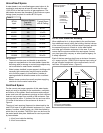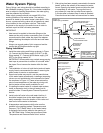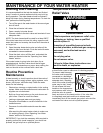
14
For protection against excessive pressures and
temperatures, a temperature and pressure relief valve
must be installed in the opening marked “T & P RELIEF
VALVE” (see Figure 15A). This valve must be design
certified by a nationally recognized testing laboratory that
maintains periodic inspection of the production of listed
equipment or materials as meeting the requirements for
Relief Valves and Automatic Shut-off Devices for Hot
Water Supply Systems, ANSI Z21.22. The function of the
temperature and pressure relief valve is to discharge water
in large quantities in the event of excessive temperature or
pressure developing in the water heater. The valve’s relief
pressure must not exceed the working pressure of the
water heater as stated on the data plate.
Figure 15A
Temperature and Pressure
Relief Valve Installation
Discharge line 3/4" minimum
Do not cap or plug.
6" maximum
Temperature and Pressure
Relief Valve
IMPORTANT: Only a new temperature and pressure
relief valve should be used with your water heater. Do not
use an old or existing valve as it may be damaged or not
adequate for the working pressure of the new water
heater. Do not place any valve between the relief valve
and the tank.
The Temperature & Pressure Relief Valve:
• Must not be in contact with any electrical part.
• Must be connected to an adequate discharge line.
• Must not be rated higher than the working pressure
shown on the data plate of the water heater.
The Discharge Line:
• Must not be smaller than the pipe size of the relief
valve or have any reducing coupling installed in the
discharge line.
• Must not be capped, blocked, plugged or contain
any valve between the relief valve and the end of the
discharge line.
• Must terminate a maximum of six inches above a floor
drain or external to the building.
• Must be capable of withstanding 250°F (121°C) without
distortion.
• Must be installed to allow complete drainage of both
the valve and discharge line.
T&P Relief Valve and Pipe Insulation (Some Models)
1. Locate the T&P Relief Valve on the water heater.
2. Locate the slit running the length of the insulation.
3 Spread this slit open and slip it over the T&P Relief Valve.
See Figure 15B. Apply gentle pressure to the insulation
to ensure it is fully seated on the T&P Relief Valve. Once
sealed secure the insulation with a section of tape.
IMPORTANT: The insulation or tape should not block
or cover the T&P Relief Valve drain opening. Also the
insulation or tape should not block or hinder access to the
T&P Relief Valve manual relief lever.
4. Next locate the hot water (outlet) & cold water (inlet) pipes
to the water heater.
5. Select one of the sections of pipe insulation and locate the
slit that runs the length of the insulation.
6. Spread the slit open at the base of the insulation and slip
it over the cold water (inlet) pipe. Apply gentle
pressure along the length of the insulation to ensure it is
fully seated around the cold water pipe. Also ensure that
the base of insulation is flush with the water heater. Once
seated, secure the insulation with a section of tape.
7. Repeat steps 5 through 6 for the hot water (outlet) pipe.
Figure 15B
T&P
Relief Valve Insulation
T&P Relief Valve
T&P Relief Valve
Drain Line
Manual Relief Lever
T&P Relief Valve Insulation
Explosion Hazard
If the temperature and pressure relief valve
is dripping or leaking, have a qualified
person replace it.
Examples of a qualified person include:
licensed plumbers, authorized gas company
personnel, and authorized service
personnel.
Do not plug valve.
Do not remove valve.
Failure to follow these instructions can
result in death, or explosion.
WARNING


















